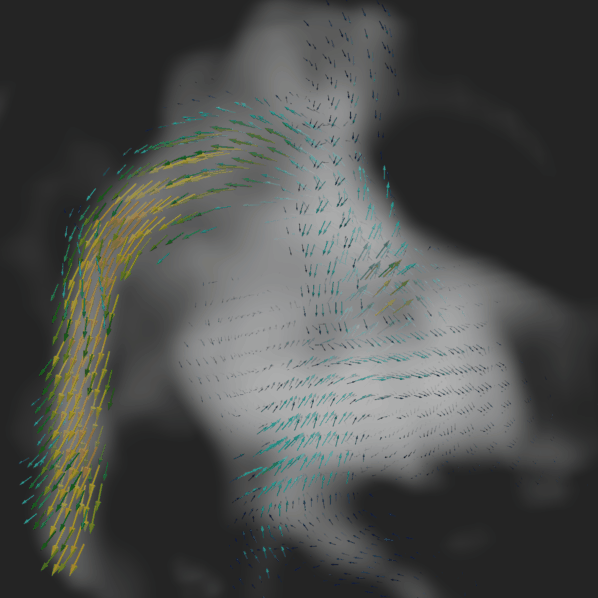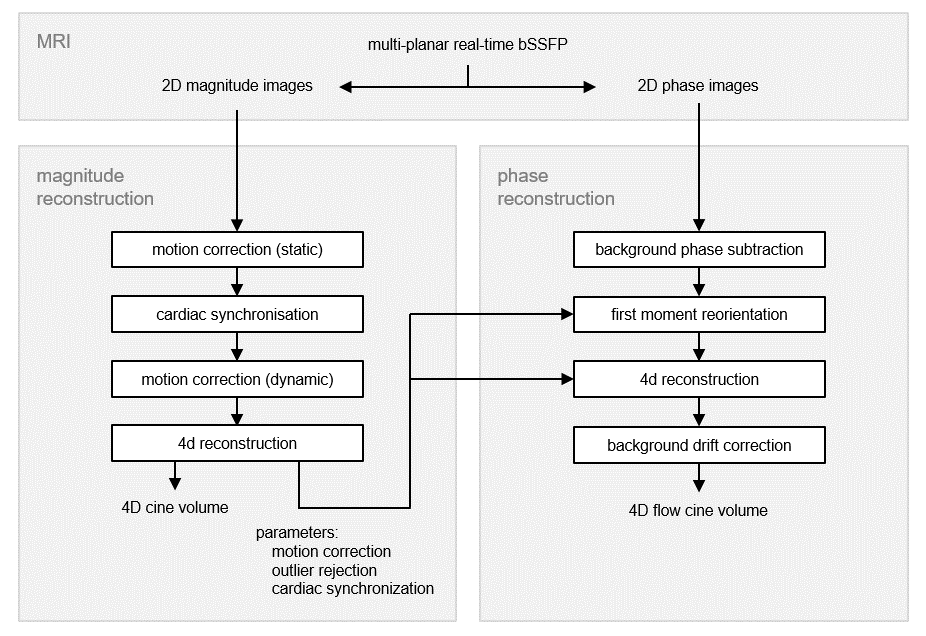fetal whole-heart 4D magnitude and flow cine reconstruction using multiple real-time non-coplanar balanced SSFP stacks
Fetal whole-heart 4D flow cine MRI using multiple non-coplanar balanced SSFP stacks
Thomas A. Roberts, Joshua FP van Amerom, Alena Uus, David FA Lloyd, Anthony N. Price, Jacques-Donald Tournier, Laurence H. Jackson, Shaihan J Malik, Milou PM van Poppel, Kuberan Pushparajah, Mary A Rutherford, Reza Rezavi, Maria Deprez, Joseph V. Hajnal.
13 May 2019. bioRxiv: 10.1101/635797 (preprint)
Fetal whole-heart 4D imaging using motion-corrected multi-planar real-time MRI
Joshua FP van Amerom, David FA Lloyd, Maria Deprez, Anthony N Price, Shaihan J Malik, Kuberan Pushparajah, Milou PM van Poppel, Mary A Rutherford, Reza Razavi, Joseph V Hajnal.
13 Apr 2019. Magnetic Resonance in Medicine. 2019. doi: 10.1002/mrm.27798 (accepted, peer-reviewed+revised)
05 Dec 2018. arXiv: 1812.02249 (preprint)
4dflow - preprocessing and postprocessing scripts for flow reconstruction
4drecon - preprocessing and 4D reconstruction scripts
SVRTK - 4D reconstruction submodule linked to github.com/SVRTK/SVRTK
cardsync - cardiac synchronisation
eval - summarise and evaluate results
ktrecon - k-t sense reconstruction submodule linked to github.com/mriphysics/ktrecon
paraview - visualisation of 4D flow volumes
synthflow_phantom - simulated flow phantom and 2D velocity-encoded slice acquisition submodule linked to github.com/tomaroberts/synthflow_phantom
Add repository to MATLAB path.
Build instructions for SVRTK can be found in the InstallationInstructions.txt file at github.com/SVRTK/SVRTK.
Install MITK Workbench for viewing data and drawing masks: mitk.org/wiki/The_Medical_Imaging_Interaction_Toolkit_(MITK). Note, 2016.11 version is known to be stable.
For Python code, install Jupyter or PyCharm.
Install Paraview for visualisation of 4D flow volumes: paraview.org. Note, version 5.4.1 is known to be stable.
Installation time varies depending on how many libraries and programs you already have installed. Typically everything can be installed in less than one hour.
ReconFrame - software platform providing the tools and the functionality to develop and execute a complete image reconstruction of Philips MR data (gyrotools.com/gt/index.php/products/reconframe)
A demo dataset can be downloaded from Figshare.
The demo dataset consists of multiple stacks of 2D slices acquired in a normal fetus. A Matlab script is included alongside the demo dataset, which follows the 4D reconstruction framework outlined below. The script comprises various Matlab functions and tells the user when to run the bash scripts.
The expected run time for the demo, from slices to 4D volumes, is 6+ hours depending on computer power and familiarity with the concepts and scripts.
Note: the nifti files provided in the demo dataset have been reconstructed using the ktrecon submodule, which requires ReconFrame. Similarly, we provide the gradient first moment text files, which we would normally automatically generate using ReconFrame.
This framework produces 4D magnitude and velocity cine volumes. The framework consists of:
PART 0 (2D MRI Acquisition and k-t SENSE Reconstruction):
- multiple stacks of real-time non-coplanar 2D bSSFP slices are acquired using a 1.5T MRI scanner and reconstructed offline using ReconFrame.
PART 1 (Anatomical Reconstruction):
- an initial motion correction stage to achieve rough spatial alignment of the fetal heart using temporal mean (i.e., static) images for stack-stack registration followed by slice-volume registration interleaved with static volume (3D) reconstruction;
- cardiac synchronisation, including heart rate estimation and slice-slice cardiac cycle alignment; and
- further motion-correction using dynamic image frames interleaved with 4D reconstruction; and
- 4D magnitude cine volume reconstruction, including outlier rejection.
PART 2 (Flow Reconstruction):
- background phase correction of phase images;
- gradient first moment reorientation to account for motion with respect to the velocity-encoding gradients;
- 4D velocity cine volume reconstruction; and
- background drift correction of 4D velocity volumes.
The reconstruction process is performed using a combination of Matlab and bash scripts which call various C++ functions in the SVRTK toolbox. A final step using Python is performed to automate visualisation of the 4D flow volumes in Paraview, however, this is optional as the .vtk files can be manually loaded into Paraview.
Note: if using the demo dataset, Part 0 can be skipped.
-
Setup
create working directories,
e.g., in shell:RECONDIR=~/path/to/recon/directory mkdir $RECONDIR mkdir $RECONDIR/data mkdir $RECONDIR/ktrecon mkdir $RECONDIR/mask mkdir $RECONDIR/cardsync
If using the demo dataset, then:
RECONDIR=~/fetal_cmr_4drecon_demo/tutorial_data -
MRI
- acquire 2D multiple non-coplanar real-time MRI stacks of 2D data
- reconstruct images using
ktrecon, e.g., for each stack, in Matlab:reconDirPath = '~/path/to/recon/directory'; seriesNo = 0; rawDataFilePath = '~/path/to/rawdata.lab'; senseRefFilePath = '~/path/to/senserefscan.lab'; coilSurveyFilePath = '~/path/to/coilsurveyscan.lab'; outputDirPath = fullfile( reconDirPath, 'ktrecon' ); outputStr = sprintf( 's%02i', seriesNo ); reconOpts = { 'GeometryCorrection', 'Yes' }; mrecon_kt( rawDataFilePath, ... 'senseref', senseRefFilePath, ... 'coilsurvey', coilSurveyFilePath, ... 'outputdir', outputDirPath, ... 'outputname', outputStr, ... 'patchversion', patchVersion,... 'reconoptionpairs', reconOpts )
- further processsing
- copy/move all magnitude-valued DC (s*_dc_ab.nii.gz) and real-time (s*_rlt_ab.nii.gz) files from 'ktrecon' directory to 'data' directory
e.g., in shell:cp ktrecon/s*_dc_ab.nii.gz data; cp ktrecon/s*_rlt_ab.nii.gz data;
- copy/move all magnitude-valued DC (s*_dc_ab.nii.gz) and real-time (s*_rlt_ab.nii.gz) files from 'ktrecon' directory to 'data' directory
-
Draw Fetal Heart Masks
- manually draw fetal heart masks for each
sXX_dc_ab.nii.gzfile (e.g., using the Medical Imaging ToolKit (MITK) Workbench)- draw ROI containing fetal heart and great vessels for each slice
- save segmentation as
sXX_mask_heart.nii.gzsegmentation in 'mask' directory
- manually draw fetal heart masks for each
-
Preprocessing
- run
preprocin Matlab,reconDir = '~/path/to/recon/directory'; S = preproc( reconDir ); save( fullfile( reconDir, 'data', 'results.mat' ), 'S', '-v7.3' );
- optionally, manually specify
- target stack by changing value in 'data/tgt_stack_no.txt' (stacks are index 1,2,...)
- excluded stacks/slices/frames by specifying in 'data/force_exclude_*.txt' (stacks/slices/frames are zero-indexed)
- run
-
Motion-Correction (static)
- create 3D mask of fetal chest
- recon reference volume,
e.g., in shell:
RECONDIR=~/path/to/recon/directory ./recon_ref_vol.bash $RECONDIR ref_vol
- recon reference volume,
- create 3D mask of fetal chest
-
Draw Fetal Chest Mask
- draw fetal chest ROI using 'ref_vol.nii.gz' as a reference (e.g., using MITK)
- save segmentation to 'mask' directory as 'mask_chest.nii.gz'
- note: the orientation of all later 3D/4D reconstructions is determined by this mask file; the orientation can be changed by applying a transformation to 'mask_chest.nii.gz' prior to further reconstructions
-
Motion-Correction (static), continued
- static (slice-wise) motion-correction,
e.g., in shell:RECONDIR=~/path/to/recon/directory˜ ./recon_dc_vol.bash $RECONDIR dc_vol
- static (slice-wise) motion-correction,
-
Cardiac Intraslice Synchronisation
- heart-rate estimation
- run
cardsync_intraslice, in Matlab:reconDir = '~/path/to/recon/directory'; dataDir = fullfile( reconDir, 'data' ); cardsyncDir = fullfile( reconDir, 'cardsync' ); M = matfile( fullfile( dataDir, 'results.mat' ) ); S = cardsync_intraslice( M.S, 'resultsDir', cardsyncDir, 'verbose', true );
- run
- heart-rate estimation
-
Reconstruct Slice Cine Volumes - recon cine volume for each slice,
e.g., in shell:shell RECONDIR=~/path/to/recon/directory ./recon_slice_cine.bash $RECONDIR- optionally, specify target slice by creating file 'data/tgt_slice_no.txt' containing target slice number (indexed starting at 1) -
Cardiac Interslice Synchronisation
- run
cardsync_interslice, in Matlab:% setup reconDir = '~/path/to/recon/directory'; dataDir = fullfile( reconDir, 'data' ); cardsyncDir = fullfile( reconDir, 'cardsync' ); cineDir = fullfile( reconDir, 'slice_cine_vol' ); M = matfile( fullfile( cardsyncDir, 'results_cardsync_intraslice.mat' ) ); % target slice tgtLoc = NaN; tgtLocFile = fullfile( dataDir, 'tgt_slice_no.txt' ); if exist( tgtLocFile , 'file' ) fid = fopen( tgtLocFile, 'r' ); tgtLoc = fscanf( fid, '%f' ); fclose( fid ); end % excluded slices excludeSlice = []; excludeSliceFile = fullfile( dataDir, 'force_exclude_slice.txt' ); if exist( excludeSliceFile , 'file' ) fid = fopen( excludeSliceFile, 'r' ); excludeSlice = fscanf( fid, '%f' ) + 1; % NOTE: slice locations in input file are zero-indexed fclose( fid ); end % slice-slice cardiac synchronisation S = cardsync_interslice( M.S, 'recondir', cineDir, 'resultsdir', cardsyncDir, 'tgtloc', tgtLoc, 'excludeloc', excludeSlice );
- run
-
Motion-Correction (dynamic) & 4D Volumetric Reconstruction
- motion correction performed interleaved with 4D Reconstruction
- recon 4D magnitude volume,
e.g., in shell:RECONDIR=~/path/to/recon/directory ./recon_cine_vol.bash $RECONDIR cine_vol
-
Motion-Correction (dynamic) & 4D Magnitude Volumetric Reconstruction
e.g., in Matlab:
matlab S = summarise_recon( '~/path/to/recon/directory/cine_vol', '~/path/to/recon/directory/cardsync', 'verbose', true ); I = plot_info( '~/path/to/recon/directory/cine_vol/info.tsv');
-
Draw Uterus Masks - manually draw uterus masks for each
sXX_dc_ab.nii.gzfile (e.g., using the Medical Imaging ToolKit (MITK) Workbench) - save segmentation assXX_mask_uterus.nii.gzsegmentation in 'mask' directory -
Background Phase Correction
- generate phase corrected stacks by subtraction of 3D polynomial
- run
fcmr_4dflow_preprocessing, in Matlab:cd(reconDir); fcmr_4dflow_preprocessing( reconDir ); disp('fcmr_4dflow_preprocessing complete ...');
- run
- generate phase corrected stacks by subtraction of 3D polynomial
-
Extract Gradient First Moments
- generate text files containing gradient first moment information for each stack
- run
fcmr_4dflow_get_first_moments, in Matlab:cd(reconDir); fcmr_4dflow_get_first_moments( reconDir ); disp('fcmr_4dflow_get_first_moments complete ...');
- run
- generate text files containing gradient first moment information for each stack
-
Gradient First Moment Reorientation & 4D Velocity Volumetric Reconstruction
- gradient first moment reorientation performed as part of 4D reconstruction
- recon 4D velocity volume,
e.g., in shell:RECONDIR=~/path/to/recon/directory ./recon_vel_vol.bash $RECONDIR vel_vol
-
Background Drift Correction
- background velocity drift correction
- recon 4D velocity volume, \
- run
fcmr_4dflow_postprocessing, in Matlab:cd(reconDir); fcmr_4dflow_postprocessing( reconDir, 'useVelDriftCorr', true, 'fileExt', 'polyCorr' ); disp('fcmr_4dflow_postprocessing complete ...');
- run
- Create 4D Volumes for Paraview
- Edit the fields of fcmr_4dflow_make_vector_vol.py to point at
RECONDIR,- run
fcmr_4dflow_make_vector_vol.py
- run
- Note: this is an optional step to automate the process of importing the data into Paraview
- alternatively, the
.vtkfiles located in/vel_vol_4d/paraviewcan be loaded from within Paraview
- alternatively, the
- Edit the fields of fcmr_4dflow_make_vector_vol.py to point at
- View 4D Blood Flow Volume in Paraview
- In Paraview,
File > Load State- Navigate to
/vel_vol_4d/paraview - Open
fcmr*_paraview.pvsm
- In Paraview,

